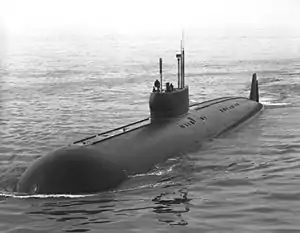Soviet submarine K-222
K-222, Soviet designation Project 661 Anchar, was a Soviet Navy nuclear-powered cruise missile submarine and the only submarine of the design.[3] It was the world's fastest submarine. Originally named K-162, it was renamed K-222 in 1978.[1] The submarine is best known in the West by its NATO reporting name Papa class.

| |
| History | |
|---|---|
| Yard number: | 501[1] |
| Laid down: | 28 December 1963[1] |
| Launched: | 21 December 1968[1] |
| Commissioned: | 31 December 1969[1] |
| Decommissioned: | 1984 in reserve, deleted from Navy list in 1989, Russian Navy flag was lowered 1999. |
| Fate: | Scrapped in 2010 at "Zvezdochka" plant (c. Severodvinsk), 3-section reactor block stand near berth №27. |
| General characteristics | |
| Class and type: | Papa-class submarine |
| Type: | Nuclear cruise missile submarine |
| Displacement: |
|
| Length: | 106.9 m (350 ft 9 in) |
| Beam: | 11.6 m (38 ft 1 in) |
| Draft: | 8 m (26 ft 3 in) |
| Propulsion: |
|
| Speed: | 44.7 knots (82.8 km/h; 51.4 mph) |
| Endurance: | 70 days |
| Test depth: | 400 m (1,312 ft 4 in) (estimated) |
| Complement: | 82 (25 officers) |
| Sensors and processing systems: | Sonar system MGK-300 "Rubin", torpedo fire control system "Ladoga-P-661", Navigation system "Sygma-661", Sonar system for mines detection "Radian-1", Radar systems RLK-101 and MTP-10, Friend or Foe detection system "Nichrom", Radio intelligence station.[2] |
| Armament: | 10 × SS-N-7 "starbright" cruise missiles in individual tubes, 4 × 533-mm torpedo-tubes (12 torpedoes) for SET-53 anti-submarine torpedoes |
Design
The project was intentionally forced to be highly innovative by discouraging the reuse of prior technical solutions.[2] While enforcing innovation, this also slowed development. Project 661 began in 1959, with design task assigned to OKB-16, one of the two predecessors (the other being SKB-143) of the famous Malachite Central Design Bureau, which would eventually become one of the three Soviet/Russian submarine design centers, along with Rubin Design Bureau and Lazurit Central Design Bureau.
K-222 was designed as an extremely fast attack submarine, and was the first submarine built with a titanium hull. She was armed with 10 SS-N-7 Starbright (П-70 «Аметист») missiles in individual tubes forward of the sail, between the inner and outer hulls, which were both of titanium alloy. Similar in design to the Charlie class, K-222 was designed to intercept and attack aircraft carrier groups. Like the Charlie class and the later Oscar class, her cruise missiles could only be reloaded in port, making its one of the Soviet Navy's "one shot" boats.
K-222 had two light-water reactors, designed to be as compact as possible. Unusually, there were no diesel generators, battery being the only emergency power source.
She is regarded as a predecessor to the Alfa and Sierra-class submarines, and may have tested technologies which were later used in those classes.
History
K-222 was laid down on 28 December 1963 and commissioned on 31 December 1969, at Severodvinsk. It was assigned to the Soviet Red Banner Northern Fleet for the duration of her career. It was the world's fastest submarine, reaching a record submerged speed of 44.7 knots (82.8 km/h; 51.4 mph) on trials. Its unofficial maximum speed, reached 30 March 1971, is 44.85 knots (83.06 km/h; 51.61 mph).[3] However, K-222's high speed came at the price of high costs during construction, and both excessive noise and significant damage to external hull features when used.
Though officially named, within the Soviet Navy the boat was commonly referred to as the "Golden Fish", in reference to its cost of development and construction.[4]
On 30 September 1980, one of K-222's nuclear reactors was damaged during maintenance in the shipyard. By 1988, it was placed in reserve at the Belomorsk Naval Base in Severodvinsk. Beginning on 5 March 2010 [5] the submarine was dismantled at Sevmash, the only facility capable of handling the titanium hull. In an unusual move, the scrapping was performed with the reactors and nuclear fuel still on board, as no provisions had been made in the design for the reactor's removal.[4] The scrapping also began before the European Bank for Reconstruction and Development (EBRD) chose an international consultant for the fuel's unloading.[4]
K-222 in popular culture
The sole Papa-class submarine is briefly featured as participating in Soviet anti-convoy operations in the Atlantic in Red Storm Rising by Tom Clancy, causing both surprise and frustration to the escorts' commanders.[6]
References
- "K-162 (6126349)". Miramar Ship Index. Retrieved 23 September 2009.
- Проект 661 (in Russian). Deepstorm.ru. Retrieved 2011-02-24.
- К-18, К-162, К-222 Проект 661 (in Russian). Deepstorm.ru. 2005-01-25. Retrieved 2011-02-24.
- "Papa class submarine K-222 scrapped". Russia & CIS Defense Policy Blog. Russiandefenseblog.org. 2010-03-04. Archived from the original on 2011-07-27. Retrieved 2011-02-24.
- 05.03.2010. "Zvezdochka dismantles unique titanium nuc sub". Rusnavy.com. Retrieved 2011-02-24.CS1 maint: numeric names: authors list (link)
- Tom Clancy, Red Storm Rising, 1989
External links
| Wikimedia Commons has media related to K-222 (submarine, 1969). |
- Project 661 (Anchar) at Bellona.no
- Project 661 Anchar Fastest submarine of the world
- Papa class submarine K-222 scrapped March 4th, 2010 (2010-03-04). "Russia & CIS Defense Policy Blog " Papa class submarine K-222 scrapped". Russiandefenseblog.org. Archived from the original on 2011-07-27. Retrieved 2011-02-24.
